Ultimate Guide to Setting Up Your Parakeet's Cage
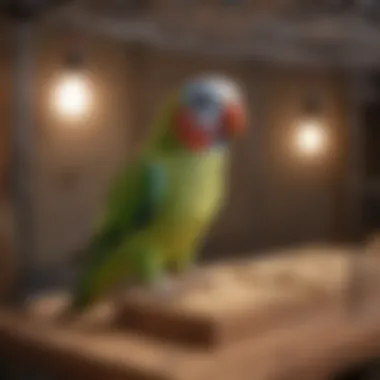
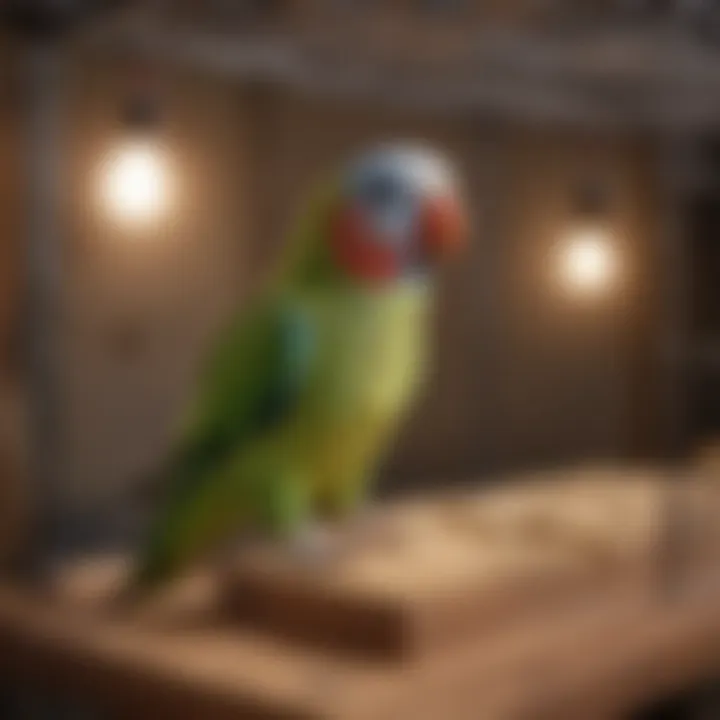
Intro
Setting up a parakeet cage is a key lesson in understanding the needs of these lively birds. Parakeets, often called budgerigars or budgies, are social creatures that thrive in environments designed for their well-being. This section serves as a foundation for your journey to creating a proper habitat for your feathered friend. By focusing on cage size, placement, equipment, and enrichment, we can ensure a happy and healthy living space for your parakeet.
Understanding Your Pet
Pet Behavior Basics
Parakeets are sociable and intelligent birds. They form strong bonds with their owners and can be trained to perform tricks or even mimic sounds. Understanding their behavior helps in developing a suitable environment. For example, parakeets often display playful traits, such as climbing and chewing. Observing these behaviors can highlight their need for exploration.
Common Breed Characteristics
Different breeds of parakeets exhibit unique traits. The most common, the budgerigar, is known for its vibrant plumage and spirited demeanor. They can be yellow, green, blue, or a combination of these colors. Recognizing individual breed characteristics can inform the setup of their cage and care routines.
Species-Specific Needs
Each parakeet species has specific requirements. For instance, larger species, like the English budgerigar, may need more space and different types of perches compared to their smaller counterparts. Being aware of these specifics is crucial for successful parakeet care.
Pet Care and Maintenance
Feeding Guidelines
Proper nutrition is essential for your parakeet's health. A balanced diet should consist of high-quality pellets, seeds, fresh fruits, and vegetables. Avoid foods toxic to birds, such as avocado or chocolate. Regular food changes also prevent stale offerings.
Grooming Essentials
While parakeets typically groom themselves, owners should assist in maintaining their feathers. Occasional baths help keep their plumage clean. Additionally, trimming beaks and nails might be necessary, but this should always be approached with caution or by a professional.
Hygiene Practices
Maintaining a clean environment is vital. Cage cleaning should occur weekly, including a thorough scrub of food and water dishes. Remove droppings regularly to avoid bacteria build-up. This keeps your pet's habitat healthy and reduces the risk of illness.
Training and Development
Basic Commands and Skills
Training your parakeet can be rewarding. Start with simple commands, like
Prelims to Parakeets and Their Needs
Understanding the needs of parakeets is crucial for providing them with a healthy and fulfilling life. Parakeets, also known as budgerigars or budgies, are vibrant and intelligent birds that require specific care and environment. A well-structured cage setup significantly influences their behavior, health, and overall well-being.
In this section, we will explore the critical aspects of parakeet behavior and their physical and social requirements. Knowing these factors helps in creating an optimal habitat that caters to their instincts and lifestyle, ultimately leading to happier birds.
Understanding Parakeet Behavior
Parakeets exhibit a range of behaviors influenced by their social nature. They are naturally inclined to live in flocks in the wild, which means isolation can cause stress and behavioral issues. Understanding this aspect can guide owners in providing opportunities for socialization, either with other birds or human companions.
Common behaviors seen in parakeets include:
- Chirping: A natural way of communicating with their flock.
- Preening: This activity keeps their feathers clean and is also a sign of relaxation.
- Exploring: Curiosity drives them to investigate their surroundings, a vital behavior for mental stimulation.
By recognizing these behaviors, owners can create a stimulating environment. Interactive toys and activities can mirror their social and exploratory instincts.
Physical and Social Requirements
The physical setup of a parakeet's cage should reflect their natural habitat and behavioral tendencies. Parakeets need enough space for movement, exercise, and social interaction.
Factors to consider include:
- Space: A cage should be spacious enough to allow flight and play. A minimum of 18 inches long by 18 inches wide and 24 inches high is often recommended.
- Safety: Ensure that the cage is free from hazards like sharp edges, and that materials used are non-toxic.
- Social Interaction: Parakeets thrive on companionship. If possible, consider keeping more than one parakeet to fulfill their social needs.
Additionally, provide opportunities to interact with humans. Regular handling can help strengthen bonds and reduce anxiety.
By tailoring the cage setup and environment to their behavior and physical needs, parakeet owners can ensure that their pets lead not only a healthy but also a fulfilling life.
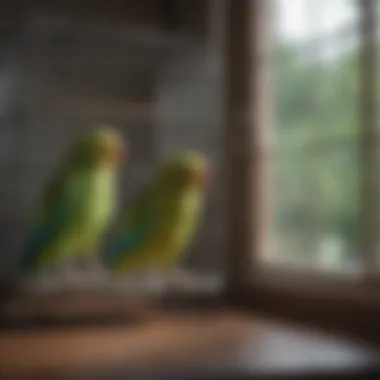
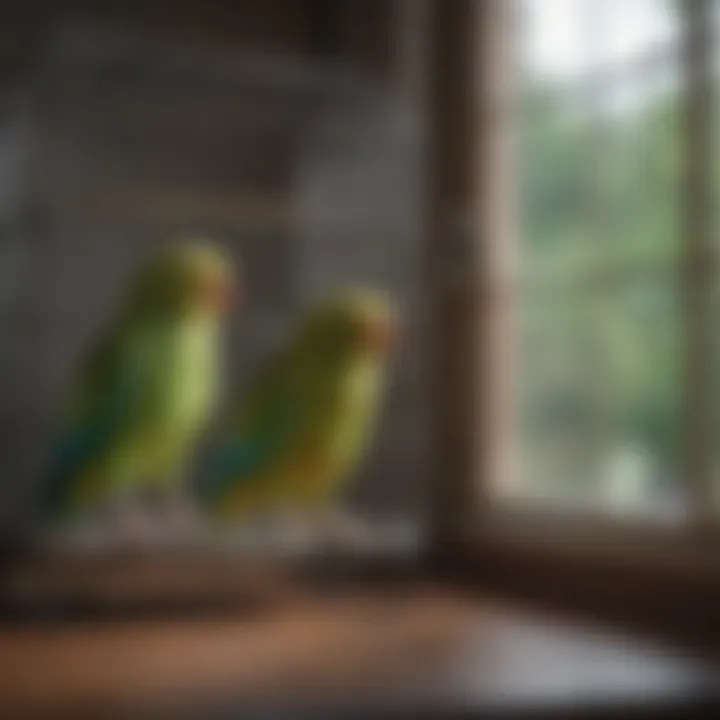
Choosing the Right Cage for Your Parakeet
Choosing the right cage for your parakeet is crucial for creating a healthy and safe environment. A cage serves as more than just a physical boundary; it is the primary habitat for your bird. The design, size, and overall quality directly affect your parakeet's quality of life. Therefore, understanding the essential elements involved in selecting a cage is vital for all parakeet owners.
Cage Size Considerations
The size of the cage significantly impacts your parakeet's well-being. Parakeets are active creatures that require ample space to move, exercise, and socialize. A cage that is too small can lead to behavioral issues such as stress or aggression. Ideally, the cage should allow the bird to stretch its wings fully without touching the walls. A good rule of thumb is to have a minimum cage space of 24 inches in length, 18 inches in width, and 18 inches in height for a single parakeet.
Keep in mind that if you plan to house multiple birds, you must increase the cage size accordingly. Multiple parakeets need additional room for their social interactions. When assessing cage size, think about your bird's lifestyle as well. Parakeets thrive in environments where they can explore. A larger cage enhances their ability to engage in natural behaviors.
Cage Material Options
Cage material plays a crucial role in the safety and durability of your parakeet's home. The most common materials are metal, plastic, and wood. Metal cages are preferred due to their longevity and ease of cleaning. Stainless steel is especially recommended, as it is resistant to rust and is more durable than other metals.
Plastic cages can be lighter and easier to move, but they may not be as sturdy or as easy to clean. Avoid cages made of treated wood, as they may contain harmful chemicals. Always choose materials that are non-toxic and safe for birds. Ensuring that the cage material is both safe and durable will help you provide a secure environment for your parakeet.
Bar Spacing and Design
The spacing of the bars in the cage is another important consideration. Proper bar spacing is necessary to prevent accidents or escapes. For parakeets, spacing should not exceed ½ inch. If the bars are too far apart, the bird may find a way to squeeze through. Conversely, too narrow spacing can pose risks of injury.
Design matters as well. Look for cages with horizontal bars. These allow birds to climb and exercise more easily. Additionally, cages with removable trays at the bottom simplify cleaning, ensuring that the habitat remains sanitary. Think about accessibility when selecting the design. Cages that include multiple doors or access points make it easier to interact with your parakeet and manage its living space.
A suitable cage should provide enough space, a safe material, and proper design to meet the needs of your parakeet.
In summary, selecting the right cage for your parakeet involves careful consideration of size, material, and design. Each aspect affects the bird's health and happiness. A well-chosen cage will set the foundation for a fulfilling life for your feathered companion.
Optimal Cage Placement
Optimal cage placement is essential for the happiness and health of your parakeet. The location of the cage influences not only the bird’s behavior but also its overall well-being. By thoughtfully selecting where to position the cage, you ensure that your parakeet has a stimulating and safe environment, which is fundamental for its development. Several factors need to be considered when determining the best location for the cage.
Factors Influencing Location
When deciding where to place the cage, consider factors like natural light, noise levels, and overall household activity. Each of these elements plays a role in creating a suitable environment for your pet bird.
- Natural Light: Parakeets thrive in spaces with ample natural light but should also have areas for shade. A location near a window can be favorable, allowing for sunlight without direct exposure that may cause overheating.
- Noise Levels: Parakeets can become stressed in loud environments. Choose a quieter spot away from televisions, speakers, or busy areas of the home where constant activity occurs.
- Household Activity: It is wise to place the cage in a location where the family spends time since parakeets enjoy social interaction. However, it should not be so busy that the bird feels overwhelmed. Find a balance to promote their mental health.
Positioning the cage thoughtfully also fosters better interaction between the bird and the family members. This social connection helps to enhance the bond between pet parakeets and their owners.
Avoiding Common Hazards
Preventing hazards in the parakeet’s surroundings is paramount. An unsafe environment can lead to serious accidents or health issues. Here are key points to consider:
- Electrical Cords and Hazards: Ensure that the cage is placed away from cords and appliances that could pose a choking or electrocution risk. Parakeets are curious, and they may chew on cords.
- Drafts and Temperature: Avoid drafty areas. Extreme temperature fluctuations can be harmful. Keep the cage away from air conditioning vents and heating sources.
- Toxic Plants and Substances: Identify plants in your home that may be toxic for birds, such as philodendrons or sago palms. Keep the cage in a space where such hazards are absent.
- Small Objects: Remove small objects that a parakeet could swallow or get caught on. This includes items like small ornaments or loose items on shelves nearby.
Remember: A safe placement can prevent potential injuries. Regularly inspect the area around the cage for any hazards that may have developed over time.
Ultimately, selecting the optimal space for your parakeet’s cage requires careful thought and attention to detail. Assess the location periodically and make adjustments as necessary. This oversight can greatly contribute to a fulfilling and healthy life for your parakeet.
Cage Accessories and Equipment
Cage accessories and equipment significantly influence the well-being of parakeets. Properly selected items can create a comfortable and stimulating environment. They contribute to both the physical and mental health of these birds, thereby enhancing their overall happiness. When setting up a parakeet cage, it is crucial to choose accessories that fulfill their basic needs while promoting active behavior.
Perches: Types and Placement
Choosing the right perches is vital for the welfare of your parakeet. There is a range of materials from which perches can be made, including wood, rope, and plastic. Natural wood perches, such as those from the Manzanita or Java trees, are highly recommended. They provide an appealing texture while offering various thicknesses, which helps strengthen your parakeet's feet.
Placement is another important consideration. It's best to install perches at different heights to create a more dynamic environment. Parakeets enjoy hopping and flying, and varying perch heights encourages physical activity. It's also ideal to avoid placing perches directly above food or water containers, to prevent droppings contaminating these essentials.
Food and Water Containers
Food and water containers are essential for the daily care of your parakeet. Opt for sturdy, easy-to-clean containers to maintain hygiene. Stainless steel bowls are often preferable as they resist staining and odors. Make sure containers are securely attached to the cage to avoid spills.
It is also beneficial to have two separate containers: one for food and the other for water. This ensures your parakeet has constant access to fresh resources. Changing water daily is key to avoiding contamination from droppings or other sources. Additionally, consider using container designs that are difficult to tip over.
Toys for Mental Stimulation
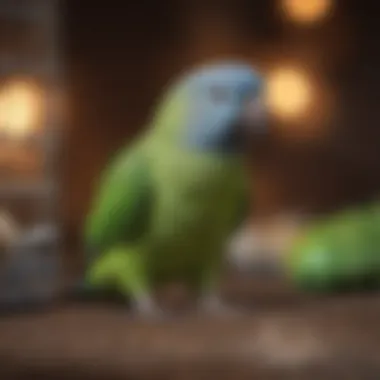
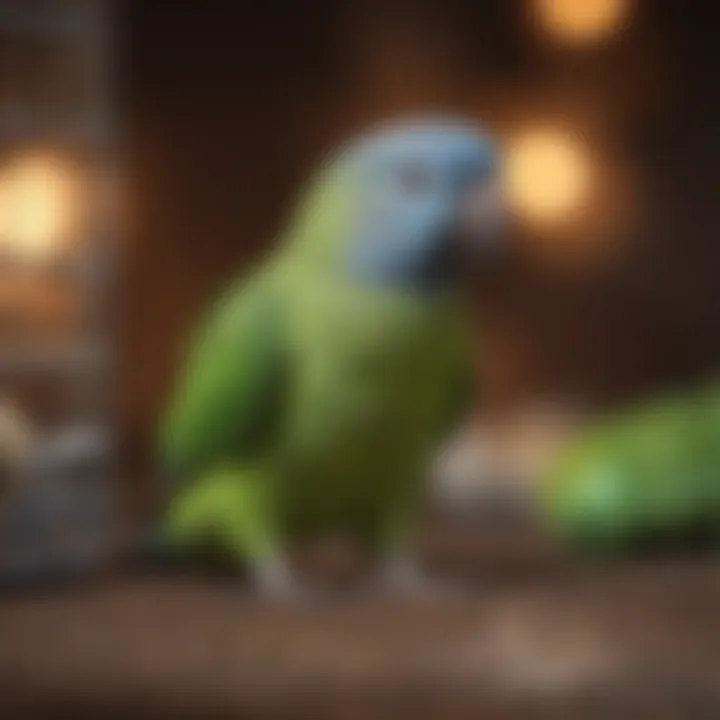
Toys play a crucial role in keeping a parakeet engaged and happy. Without proper mental stimulation, these birds may become bored and stressed. A variety of toys can be included in the cage. These can range from simple wooden chews to more complex puzzle toys.
Consider the following types of toys:
- Chew Toys: Help keep their beaks healthy while providing entertainment.
- Swing Toys: Encourage movement and provide a different perspective.
- Interactive Toys: Challenge their intellect and promote problem-solving abilities.
When selecting toys, be cautious about materials. Avoid those made from toxic substances. Additionally, regularly rotate toys to maintain their interest. An engaged parakeet is a healthier bird, emphasizing the importance of these accessories in their space.
Providing the right accessories and equipment is essential for the mental and physical health of parakeets.
In summary, proper cage accessories and equipment contribute immensely to the well-being of parakeets. Selecting the correct perches, reliable food and water containers, and engaging toys enriches their environment and fulfills their needs.
Environmental Enrichment Strategies
Environmental enrichment is crucial for the well-being of parakeets. These strategies contribute to the mental and physical health of your birds, making their lives more fulfilling and enjoyable. Providing a stimulating environment helps reduce stress, boredom, and destructive behaviors that may arise from confinement. It encourages parakeets to engage in natural behaviors, which is essential for their happiness and overall health. When you consider environmental enrichment, think about both physical and interactive components that can enhance your parakeet's habitat.
Natural Elements to Include
One effective way to enrich a parakeet's environment is by incorporating natural elements into their cage setup. This can create a more inviting and engaging space for your birds. Here are some ideas to consider:
- Branches and Twigs: Use non-toxic, untreated branches for perches. Birds enjoy grasping and climbing on them. You can also make foraging opportunities by hiding treats within the branches.
- Natural Plants: Certain edible plants can safely be included in the cage. Safe options include spider plants and bald cypress. They not only enhance the aesthetic appeal but also provide natural items for interaction.
- Grass Mats or Natural Bed Liners: These can serve as a comfortable area for your parakeets to rest while offering textures for them to explore.
Including these elements will not only beautify the cage but also create a more instinctual environment for your parakeets. Remember to regularly inspect any natural materials added to the cage, ensuring they remain safe and free from mold or pests.
Interactive Play Opportunities
Parakeets are intelligent creatures that thrive on interaction and stimulation. Engaging them through play opportunities is vital for their mental sharpness and overall contentment. Here are some ways to encourage active participation:
- Toys: Provide a variety of toys that promote play. Chew toys, swings, and ladders encourage activity and can help prevent boredom. Rotate toys regularly to maintain interest.
- Puzzle Feeders: These feeders require parakeets to engage in problem-solving to access food. This not only provides enrichment but can also slow down their eating, which is beneficial for their digestive health.
- Interactive Playtime: Spend quality time out of the cage with your parakeet. Utilize playstands or designated play areas to safely engage your bird. Teach them tricks or offer treats to reward interaction.
Maintaining Cleanliness in the Cage
Maintaining cleanliness in your parakeet’s cage is a fundamental aspect of responsible pet ownership. A clean cage is not only visually appealing but also crucial for the health and well-being of your parakeet. Regular cleaning helps to prevent the growth of harmful bacteria, reduces odors, and creates a healthier environment for your feathered friend. Neglecting cleanliness can lead to various health issues for your parakeet, including respiratory problems and infections.
Regular Cleaning Routines
Establishing a regular cleaning routine is essential for keeping your parakeet's living space hygienic. Here are some specific guidelines to consider:
- Daily Tasks: Remove uneaten food and change the water daily. Check for any droppings on perches and toys to ensure they are clean. Wipe down surfaces to eliminate any residue that may accumulate.
- Weekly Cleaning: At least once a week, take everything out of the cage, including perches, toys, and food bowls. Wash these items with warm, soapy water, then rinse thoroughly to remove soap residue. Clean the cage itself with a mild disinfectant suitable for birds, ensuring it is safe and non-toxic.
- Monthly Deep Cleaning: Every month, schedule a deeper clean. Replace any worn or damaged items and scrub the cage more vigorously. This is a good time to check for any potential hazards, such as sharp edges or broken parts.
Creating a checklist for these routines can help you stay organized and ensure that no steps are overlooked. Consistent efforts will lead to better hygiene and a happier, healthier parakeet.
Sanitation and Health Considerations
The sanitation of your parakeet’s cage directly influences their overall health. By understanding the key considerations, you can mitigate risks effectively. Factors to keep in mind include:
- Waste Management: Parakeets produce waste frequently, and its buildup can lead to a breeding ground for bacteria. This can cause illnesses not only for the bird but for humans as well, as some diseases can be transmitted.
- Food Hygiene: Ensure that food containers are cleaned regularly. Bacteria can grow on old food remnants. Use stainless steel containers that are easily washable. Replace perishable items promptly and monitor the freshness of the food provided.
- Ventilation: Proper airflow within the cage is necessary to prevent mold and mildew from forming. Good ventilation reduces humidity, which is important for keeping the environment dry and healthy.
Safety Considerations for Cage Setup
Creating a safe environment for your parakeet is paramount when setting up their cage. Safety considerations not only protect your bird from potential harm but also nurture their overall well-being. Ensuring that the cage is free of hazards will help create an ideal habitat that allows your parakeet to thrive. Here, we will explore key safety elements including avoiding toxic materials and preventing escapes, which are crucial aspects of responsible pet ownership.
Avoiding Toxic Materials
When setting up a cage, one of the primary safety considerations is to avoid the use of toxic materials. Parakeets have delicate respiratory systems and can be sensitive to certain substances. Common household items that may seem harmless can pose significant risks. Some materials to steer clear of include:
- Non-Food Safe Paints and Coatings: Many paints contain harmful chemicals that can be toxic to birds. Always opt for bird-safe paint or no paint at all.
- Plastic that Contains BPA: Certain plastics can release harmful chemicals. Choose BPA-free options for anything your bird might chew on.
- Treated Wood: Wood that has been chemically treated for outdoor use may contain harmful substances. Ensure any wood in the cage is untreated and safe for birds.
Be vigilant about the materials you introduce to your parakeet's environment. Research before purchasing any accessories or equipment for the cage. Using natural, untreated materials wherever possible minimizes risk and keeps your bird safe.
Preventing Escapes
Keeping your parakeet safely contained within its cage is another critical consideration. Even the smallest gaps or weaknesses in the cage structure can lead to unwanted escapes. To prevent this, consider the following:
- Cage Door Design: Ensure that the cage doors lock securely. Simple latches may be inadequate, as clever parakeets can discover how to open them. Look for cages with mechanisms that require a specific method to open.
- Check Bar Spacing: The spacing between bars should not be wide enough for your parakeet to squeeze through. This is especially important for smaller parakeets. A gap of ½ inch or less is typically safe.
- Secure Loose Parts: Regularly inspect the cage for loose components. Sometimes, toys or accessories can shift and create gaps where a bird could escape.
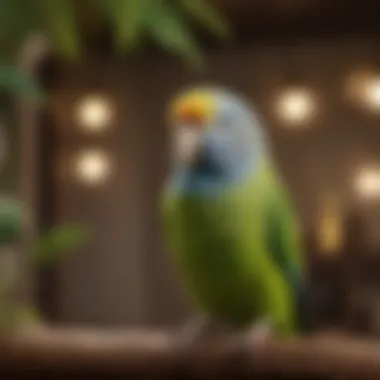
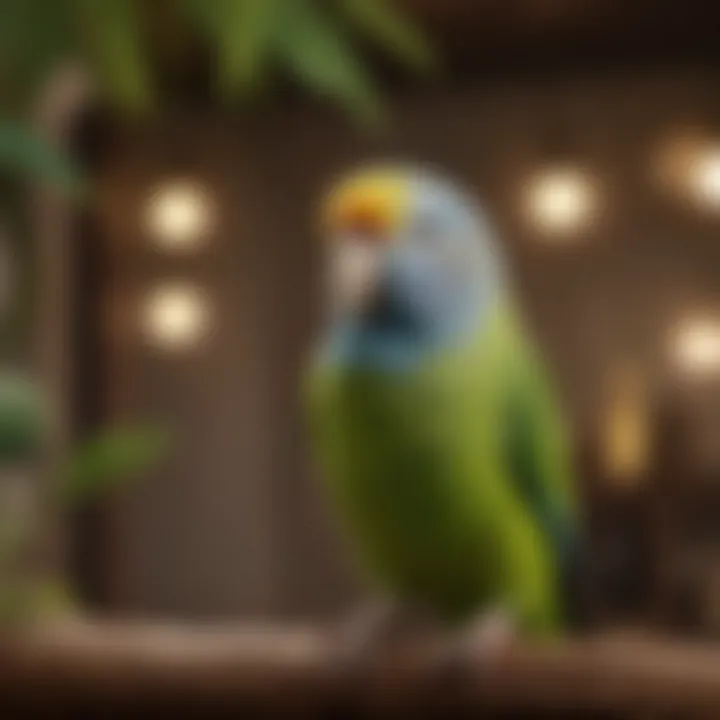
Regular maintenance of the cage can save you from future troubles. Always check the integrity of the cage before allowing your parakeet to explore.
By focusing on safety considerations, you create a nurturing space for your parakeet, allowing them to express their natural behaviors while minimizing risks. Prioritizing a safe cage environment is essential in your journey as a responsible parakeet owner. Each of these steps will contribute to the overall happiness and health of your avian companion.
Introducing a Parakeet to Its New Cage
Introducing a parakeet to its new cage requires careful consideration and planning. This process is critical for developing trust and a sense of security for the bird in its new environment. A well-executed introduction can ultimately lead to a happy and healthy parakeet. This topic covers essential elements such as creating an ideal environment and allowing time for adjustment.
Creating a Calm Environment
Setting the right tone is vital when introducing your parakeet to its cage. The new space should feel safe, not chaotic or overwhelming. Here are some strategies to help achieve this:
- Minimize Noise: Place the cage in a quiet area of your home. Loud sounds can stress the bird.
- Controlled Lighting: Ensure that the cage is well-lit but avoid direct sunlight. Consistent, soft lighting helps the bird acclimate.
- Avoid Sudden Movements: When interacting with the cage, move slowly and gently. Fast actions may frighten the parakeet.
Additionally, using a calming voice when speaking near the cage can help the bird feel more at ease. Offer familiar items, such as toys or perches, from its previous home to provide comfort. Having familiar scents may also create a sense of safety.
Observation and Adjustment Period
Every parakeet is unique, and they may respond differently to their new surroundings. During the first few days, it’s essential to observe the bird's behavior and reactions.
- Monitoring Behavior: Look for signs of stress, like excessive chirping or flapping. If the bird hides or does not eat, it might need more time to adjust.
- Gradual Interaction: After a few days of observation, start interacting at a slow pace. Introduce yourself quietly, and try to engage through gentle sounds or soft words to reduce anxiety.
This adjustment period can last from several days to weeks, depending on the individual bird. Be patient and flexible. Create an environment where the parakeet feels safe to explore. Regularly check food and water consumption as a part of this monitoring phase to ensure its well-being.
It is crucial to remember that every bird is different, and patience is key. Rushing the introduction can lead to stress and fear, making adjustments more difficult.
By considering these factors and remaining observant, you can facilitate a smoother transition for your parakeet. A patient approach will foster trust and encourage your parakeet to connect with its new home.
Monitoring Your Parakeet's Health and Well-being
Monitoring your parakeet's health and well-being is critical. Regular observation can help you spot any shifts in behavior, signaling potential issues. Healthy parakeets are lively companions. If you notice changes, it may require immediate attention. This section will cover essential factors you should keep in mind.
Behavioral Signs of Stress or Illness
Parakeets have distinct behaviors that indicate they are unwell or stressed. One sign to watch for is a decrease in activity. If your bird is usually active but suddenly becomes lethargic, it could be a sign of illness. Additionally, changes in vocalizations may suggest discomfort. A parakeet that usually chirps or sings may become silent or produce harsh, unusual sounds.
You should also look for alterations in eating habits. If your parakeet stops eating or drinks less water, it could signal health problems. Feather plucking or excessive preening also indicates stress or illness. When observing your bird, remember these signs:
- Decreased activity: Less movement may signal trouble.
- Change in vocalization: Listen for unusual sounds.
- Altered eating habits: Monitor food and water intake.
- Feather issues: Watch for excessive preening or plucking.
It’s paramount that parakeet owners become familiar with the regular behavior of their birds. By doing so, owners can quickly identify any deviations from the norm that could suggest health concerns.
Regular monitoring can safeguard your parakeet's health and enhance overall well-being.
Consulting with a Veterinarian
If you observe concerning signs, consulting with a veterinarian is essential. A vet experienced in avian care will provide comprehensive assessments. They can assess your bird's health accurately, advising on necessary treatments.
When preparing for such a consultation, bring notes. Document any behavioral changes, dietary habits, and general observations. This information will assist the veterinarian in making informed decisions. Timing is also critical. Don't wait too long to seek advice when health issues arise.
Ensure you choose a vet comfortable handling birds. Not all veterinarians are familiar with parakeets, so do research ahead of time. Regular check-ups are advisable. They help in early detection of potential issues, fostering a better quality of life for your pet.
In conjuntion with vet care, maintain a stable environment at home. Minimize stressors that can affect your parakeet's health. By prioritizing their welfare, you create a nurturing environment that promotes a happy and healthy life.
Closure: Setting Up for Success
Creating an appropriate environment for your parakeet is crucial for its health and happiness. The conclusion centers on the importance of revisiting the cage setup regularly. This not only assures that the environment remains conducive for your pet, but also allows for adjustments that reflect the changing needs of your parakeet as it grows and ages. A well-considered cage setup fosters a positive relationship between you and your feathered companion.
Revisiting the Cage Setup Regularly
Regular assessments of your parakeet's living space can make a significant difference in its well-being. This involves evaluating the size of the cage, the arrangement of accessories, and the general condition of the habitat.
- Cage Size Adjustments: As your parakeet matures, its space requirements may change. A larger cage may be necessary if the bird grows more active or if you decide to add companions.
- Accessory Rotation: Perches, toys, and other equipment should be rotated consistently. Parakeets can grow bored with their habitat, so changing the position of accessories can create a stimulating environment. Regular changes also help encourage explorations and reduce stress.
- Cleaning and Maintenance: Routine cleaning should be part of the reassessment. Ensure the cage remains hygienic and safe for your parakeet. A clean habitat is vital for preventing health issues.
In summary, constantly revisiting the cage setup ensures it caters well to the parakeet’s evolving needs, promoting a more enjoyable life.
The Long-term Commitment of Parakeet Care
Owning a parakeet is a long-term commitment that requires ongoing effort and understanding. The essence of this commitment lies in recognizing that your bird relies on you for its sustenance, safety, and social needs.
- Expectations: Be prepared for a lifetime commitment. Parakeets can live 10 years or longer with proper care. This longevity means that consistent attention to their needs must be part of your lifestyle.
- Consistent Engagement: Social interaction is crucial for parakeets. They require regular engagement with their owners to foster their social well-being. Involvement can include talking to them, trainng or allowing them to fly under supervision.
- Health Monitoring: Regular vet check-ups enhance your parakeet's health. Staying informed about potential health issues and prompt intervention can secure a longer life for your bird.







